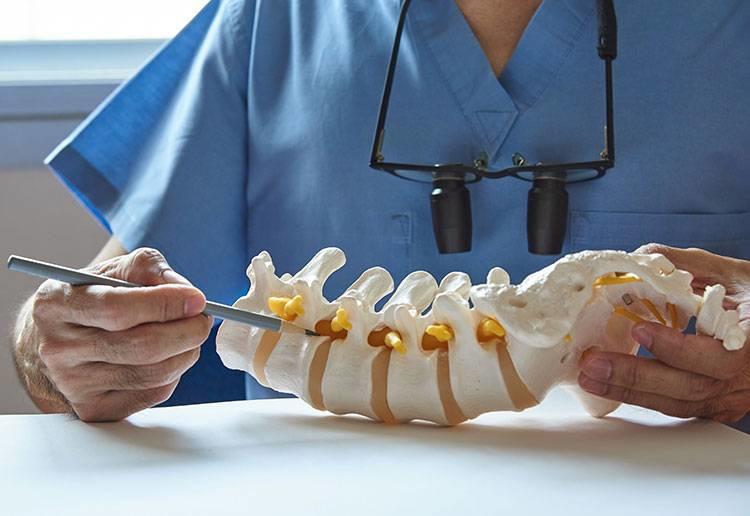The spine is one of the most important components in the human body as it allows you to bend, twist, extend, and more. However, due to the many functions of the spine, it is susceptible to injury. One of the common sources of back pain is developing annular tears in one of the spinal discs. These annular tears may go unnoticed at first, but if they are left untreated, they can lead to a variety of other spine issues.
What is a Spinal Disc Tear?
Your spine is made up of 24 vertebrae, the sacrum, and the coccyx. Each of the 24 vertebrae is separated from the one above it and below it by an intervertebral disc. These discs are composed of two separate components: the nucleus pulposus and the annulus fibrosis.
The nucleus pulposus is found on the inside of the disc. It is jelly-like in appearance and is responsible for dealing with compressive forces, which can occur from lifting, bending, or twisting motions. This part of the spinal disc is also responsible for maintaining the total height of the discs. Disc height is important because it prevents the vertebrae from rubbing against each other.
The annulus fibrosis makes up the outer layer of the spinal disc. This layer is tough and functions as a spine stabilizer as it connects the vertebrae to one another. The outer portion of the intervertebral disc is able to compress slightly, but it generally is quite rigid and provides a barrier around the inner layer to prevent it from leaking.
When annular tears occur, the annulus fibrosis on the outside of the disc breaks down and develops annular tears. Annular Tears can arise for a variety of reasons, including degeneration or traumatic injury. Disc degeneration occurs with age or due to certain diseases. When discs degenerate, they can begin to break down, dry out, and leak. This can make them susceptible to annular tears with only simple, everyday motions.
If a tear does develop in the outer layer, the nucleus pulposus can begin to leak out, causing a herniated disc. This can place pressure on the nerves surrounding the disc, which may result in muscle weakness or numbness or tingling in the arms or legs.
What are the Symptoms of a Disc Tear?
In many cases, annular tears may go unnoticed and be completely asymptomatic. On the other hand, you may become aware of a pain in your neck or back, depending on the exact location of the tear. If the tear is in the lower back, you may notice that the pain radiates into your buttocks or down your leg (which can be easily confused with sciatica).
You may also notice that the pain may become more severe when you perform certain motions. Pain levels could increase when you sit down or when you complete tasks that require twisting, bending or lifting.
The pain you feel may be constant or only sporadic in nature, and it may be alleviated when you change positions or if you lay down. Pain may also be reduced when you are in motion and may not act up until you stop exercising. As we mentioned above, annular tears can result in nerves being pinched, causing pain in the lower back, glutes, and legs.
What Tests can be Done to Diagnose Annular Tears?
There are a number of different tests that can be used to determine whether or not annular tears or herniation has occurred. The most common of these tests is an MRI, which stands for magnetic resonance imaging. MRIs are often used in order to diagnose whether or not a nerve has been pinched by a herniated disc.
Another common test is a CT myelogram. This test involves injecting a dye into the spinal fluid. Then, either an x-ray or computed tomography is used to analyze the spinal canal and identify any potential issues surrounding the spine.
A discogram, also known as an annulogram, is another common test to look for disc tears. This test involves injecting dye directly into the intervertebral disc that is believed to be torn. If there are annular tears, the dye will begin to fill the cracks in the disc or leak out. A CT scan or x-ray can be used to reveal any damage that has occurred.
Spinal discs play critical roles in the body, but they can become fragile over time. If your intervertebral discs begin to break down and degenerate, they can become less resilient and develop annular tears in the outer layer. This can cause your discs to leak, vertebrae to rub together, and nerves to be pinched. While the potential symptoms of annular tears can vary significantly, it is important to obtain the proper diagnosis and treatment to prevent further issues from occurring and to restore your spine’s integrity and original functionality.
https://www.mayoclinic.org/diseases-conditions/herniated-disk/symptoms-causes/syc-20354095
https://www.webmd.com/back-pain/degenerative-disk-disease-overview#1
https://www.hopkinsmedicine.org/health/treatment-tests-and-therapies/myelogram
https://www.mayoclinic.org/tests-procedures/discogram/about/pac-20393818
